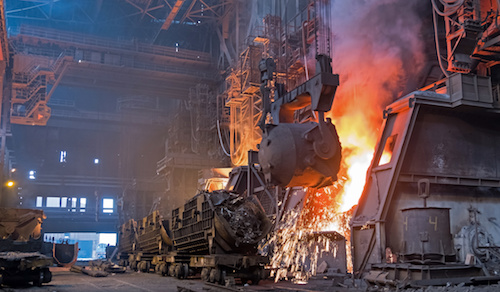Amid Plunging U.S. Steel Prices, Has ‘Steelmageddon’ Arrived?
Editor’s Note: This article has been corrected to reflect the most recent AISI capacity utilization rates and the price delta between the ROW and the US.
Judging by the plunging share price of steel producers and the collapse in steel prices from $1,006 per ton just over two years ago to $557 now, it would seem that Steelmageddon — the term famously coined by Bank of America Merrill Lynch — is upon us.
Or is it?
Keep up to date on everything going on in the world of trade and tariffs via MetalMiner’s Trade Resource Center.
A recent Fortune article puts steel producers at fault for rushing to restart idled capacity and even investing in new facilities following President Donald Trump’s imposition of a 25% import duty in 2018.
The measure did meet its objective of lifting capacity utilization from 73% to 80%, as domestic steel mills became more competitive behind the tariff barrier. Though utilization rates dipped in late August through mid-October, they have since come back above 80%.
If that were the end of the story, it is possible steel producers would still be able to play the market by maximizing sales with their 25% buffer against imported steel.
As exemptions have been granted to major trading partners such as Canada and Mexico, that has minimized the benefits of the tariffs for domestic producers. Initially, U.S. producers were at best only 1-2% below the price of imported steel, taking the majority of the 25% as increased profit.
But today, the price delta between the ROW and the U.S. is virtually nonexistent.
Some would argue a global trade war waged by the president, specifically but not exclusively with China, has also contributed to a slowing of steel demand. The counter-argument suggests that while we have seen a drop from 2018, the reality is that we might be at the end of a long-running expansionary business cycle that would have seen slower demand anyway.
The article argues the rise in domestic steel prices has made some U.S. manufacturers less competitive for both domestic sales and their exports. But our own data suggests that 12 out of 18 manufacturing sectors in 2018 had record profits, despite tariffs.
Now, steel plants are being idled again as oversupply is depressing prices below the level seen even before the imposition of the 25% import tariff.
CNN reported U.S. Steel recently announced it would temporarily shut down a blast furnace at its venerable Gary, Indiana facility, another at a facility near Detroit and idle a third plant in Europe due to weak demand and oversupply.
Steel producers’ earnings have headed south in lockstep with falling demand.
Fortune states the combined earnings of U.S. Steel, AK Steel, Steel Dynamics and Nucor tumbled more than 50% in the first two quarters of this year. Capacity utilization dipped back below the 80% target primarily in September and October but has since recovered to 81.6% according to the latest AISI data for the week ending Nov. 2 and year-to-date capacity utilization reached 80.3% compared with 77.5% from a year ago.
The basis of the Section 232 justification was that the U.S. needed to maintain a level of investment and capability in the steel industry as a matter of national security, that certain steels were critical for military and strategic requirements.
Although the defense secretary at the time, James Mattis, said the military needed just 3% of U.S. production of steel and aluminum and that imports didn’t hinder its ability to protect the nation, there are some countries – the U.K. is an example — where the domestic steel industry has been allowed to wither so significantly that it now relies on imports of critical defense materials, like steel, for the hulls of its nuclear submarines.
A better counter would be to question whether tariffs were and remain the best way to protect investment and capability in those strategic areas of production.
Free Partial Sample Report: 2020 MetalMiner Annual Metals Outlook
Either way, a global slowdown, coupled with a rush to return capacity to production, has created an oversupplied market in which steelmakers have suffered.
Nor will demand return anytime soon if the World Steel Association is correct.
The association forecast U.S. steel demand will slow to 1% in 2019 (from 2.1% growth last year). In 2020, growth is expected to crawl to just 0.4%, quite possibly prompting the closure of yet more mills and a return to pre-tariff levels of profitability and capacity utilization.
That’s not what the market or the industry wanted. However, to answer the headline, until we see a crash in the steel capacity utilization rate, it’s hard to argue Steelmageddon has arrived.



4 Comments
Hate to admit to being the dummy in the room, but what is “ROW”, in context of this sentence in the above article’ “But today, the price delta between the ROW and the U.S. is virtually nonexistent.”?
Thank you,
rest of world I am guessing
Rest of The World. US Price – $557/ton.
Benchmark Export price ~$500/ton +shipping
IMPEACH TRUMP
PROBLEM SOLVED